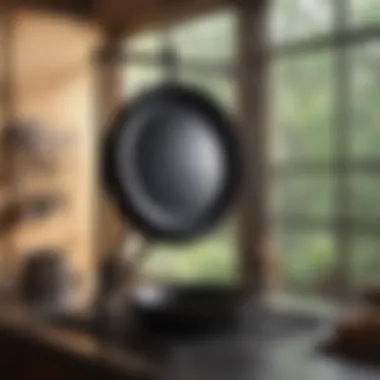Essential Guide to Cast Iron Skillet Care


Intro
Understanding the proper maintenance of cast iron skillets is crucial for anyone who wishes to preserve the longevity and performance of this valuable kitchen tool. Many may underestimate the unique qualities of cast iron, yet with appropriate care, a skillet can last for generations. This guide aims to present you with structured and well-researched methods for post-cooking maintenance. Whether you are a novice or an experienced user in the kitchen, mastering the art of cast iron skillet care can enhance your cooking experience considerably.
Importance of Cast Iron Skillet Care
Caring for cast iron skillets is not merely about routine cleaning. It involves a series of steps that, when executed correctly, can prevent rust, create a non-stick surface, and retain the skillet's natural seasoning. In addition
- Rust Prevention: Regular maintenance helps to keep your skillet free from moisture, which is essential in preventing rust.
- Enhanced Cooking Performance: A well-seasoned skillet promotes better heat retention and distribution.
- Longevity: Proper care means your skillet can potentially be passed down as an heirloom.
These factors underline the necessity for a careful approach to cleaning, seasoning, drying, and long-term storage of your skillet.
Overview of Maintenance Steps
This guide will delve into specific methods for:
- Cleaning: Strategies to clean the skillet effectively post-cooking without damaging the surface.
- Seasoning: Techniques for enhancing the non-stick properties and flavor retention of the skillet.
- Drying: Best practices for ensuring that the skillet is dried properly after washing.
- Long-term Storage: Tips on how to store the skillet to maintain its quality over time.
By the end of this article, readers will gain a comprehensive understanding of how to maintain their cast iron skillets, maximizing both their functionality and longevity.
Prelude to Cast Iron Skillets
Cast iron skillets are renowned for their capacity to retain heat and distribute it evenly, making them a favorite among professional chefs and home cooks alike. In this article, we explore the fundamental aspects of maintaining cast iron cookware post-cooking to ensure longevity and performance. Proper care is essential for preserving these skillets' unique properties and enhancing their functionality throughout their lifespan.
Understanding Cast Iron Cookware
Cast iron cookware has a history that stretches back centuries. The durability of cast iron is unmatched, and it can withstand high temperatures, making it perfect for various cooking methods such as searing, frying, and baking. Additionally, cast iron skillets develop a natural non-stick surface when seasoned correctly, which adds to their versatility. It’s important to understand how this material works to appreciate its capabilities and maintenance needs.
Over time, the seasoning of a cast iron skillet improves. Seasoning is the process of applying oil and heating it to create a polymerized layer that protects the skillet from moisture and imparts a natural non-stick quality. This layer is created through repeated use and care, making the understanding of seasoning pivotal for users.
Benefits of Using Cast Iron Skillets
Using cast iron skillets comes with numerous benefits that set them apart from other cookware materials:
- Excellent Heat Retention: Cast iron retains heat effectively and distributes it evenly, making it ideal for cooking a variety of dishes.
- Versatility: These skillets can be used on the stove, in the oven, or over an open flame, providing a range of cooking options.
- Natural Non-Stick Surface: With proper seasoning, cast iron skillets achieve a non-stick surface that enhances cooking and cleaning experiences.
- Nutritional Benefits: Cooking with cast iron may increase dietary iron intake, beneficial for many individuals.
- Longevity: When maintained properly, cast iron cookware can last for generations, making it a worthwhile investment.
Users should appreciate these benefits as they underscore the value of proper maintenance practices for optimal cooking experiences and cookware longevity.
Immediate Care After Cooking
Caring for a cast iron skillet right after cooking is crucial for maintaining its performance and lifespan. Immediate care involves addressing any residues, assessing the skillet's condition, and preventing long-term damage. Ignoring this step can lead to rust, food build-up, or even degradation of the skillet's seasoning. Thus, proper immediate care establishes a foundation for successful long-term usage.
Assessing the Cookware Condition
After cooking, the first task is to evaluate the condition of your cast iron skillet. Look for any food particles stuck to the surface or signs of residue build-up. A simple visual inspection can tell you if your skillet is clean or needs more attention. If the surface appears discolored or if food has been burnt onto it, then it requires prompt cleaning to avoid damage.
It's also wise to check if there are any cracks or chips. Although rare in well-maintained cast iron, even small imperfections can lead to larger issues over time. Using the skillet consistently while it's in a compromised state will only exacerbate the problem. Take a moment to inspect your cooking tool thoroughly after each use.
Avoiding Common Mistakes


Many users fail to properly care for their cast iron skillets, leading to unfortunate results. Here are key points to consider:
- Using abrasive tools: Steel wool or harsh scrubbers can strip the seasoning of your skillet. Instead, opt for a soft sponge or brush specifically designed for cast iron care.
- Soaking in water: Leaving your skillet submerged in water can promote rust formation. Always dry your skillet promptly after cleaning.
- Neglecting to dry thoroughly: An improperly dried skillet can lead to corrosion. Make sure to dry it fully before storing away.
- Skipping seasoning: If the skillet appears dull or less non-stick, it may need a light coat of oil for seasoning. Regularly maintaining the seasoning is crucial to preserving the skillet's quality.
By being mindful and attentive in these aspects, you ensure that your cast iron skillet remains a valuable asset in your kitchen.
Cleaning Process for Cast Iron Skillets
Cleaning cast iron skillets is a crucial step in maintaining their longevity and usability. The cleaning process not only removes food residues but also helps in preserving the skillet’s seasoning, which is vital for its non-stick properties. Proper cleaning methods prevent rust and ensure that the skillet remains in optimal condition for future cooking. A well-maintained cast iron skillet can last for generations, making it a beloved piece of cookware in many kitchens.
Removing Food Residues
After cooking, it is essential to remove any food residues left on the skillet. This might seem obvious, but the method of removal is significant. Using a spatula or a brush designed for cast iron can efficiently scrape off food particles without damaging the surface. Avoid using steel wool or harsh scrubbing pads as these can strip away the layer of seasoning you have built up over time.
Additionally, if there are stubborn food residues, consider soaking the skillet in warm water for a few minutes. This softens the residue and makes it easier to clean without harsh scrubbing, which can harm the skillet's finish. Upon removal, ensure to dry it thoroughly to avoid moisture buildup, which can lead to rust.
Choosing the Right Cleaning Tools
The tools you choose for cleaning a cast iron skillet will greatly affect its longevity. Opt for brushes or sponges specifically designed for cast iron. A stiff bristle brush can be ideal for tough spots, while a soft sponge can be used for general cleaning. Make sure any tool you use is free from synthetic materials which may scratch or damage the skillet.
It’s also worth noting that certain cleaning cloths or towels can absorb moisture, assisting in drying. It's essential to keep the skillet dry to avoid unwanted rust formation. Investing in dedicated cleaning tools will extend the life of your skillet and enhance your cooking experience.
Using Water and Soap - A Controversial Topic
Using water and soap on cast iron skillets sparks a debate among cooking enthusiasts. Traditionally, it’s advised to avoid soap, as it can strip away the seasoning that makes cast iron non-stick. However, mild soap is often acceptable if used sparingly. The key is to apply soap only when absolutely required, such as when there are strong food odors or residues that cannot be removed otherwise.
When washing with soap, follow these guidelines:
- Use a small amount of mild soap.
- Rinse the skillet immediately to ensure no soap residue remains.
- Always dry your skillet completely after washing.
Remember, proper seasoning will protect your skillet. If the seasoning is maintained, light soap use should not hinder the skillet's performance.
Drying Techniques After Cleaning
Drying your cast iron skillet is a crucial step that ensures the longevity of this beloved kitchen tool. If moisture remains in the skillet, rust formation can occur, compromising the integrity of the cast iron. Thorough drying influences the effectiveness of the seasoning and helps maintain that characteristic non-stick surface. Thus, mastering the drying techniques is critical to effective cast iron maintenance.
Importance of Thorough Drying
Thorough drying is important for several reasons. First, it prevents rust. Cast iron is highly susceptible to rust when exposed to moisture. Even a small amount of water can accelerate rust formation. This oxidation not only affects the appearance of the skillet but also its cooking performance.
Second, proper drying allows the seasoning to adhere better. Seasoning is a layer of oil that forms a protective barrier on the skillet's surface. If there is moisture left on the skillet, it can interfere with the oil's ability to bond effectively. Therefore, ensuring the skillet is completely dry is essential for maintaining its non-stick characteristics.
Additionally, thorough drying reduces the risk of food particles and bacteria thriving on a damp surface. A well-dried skillet is less prone to harbor residue that might affect food safety and flavor.
Methods to Dry Cast Iron Skillets
There are several effective methods to dry cast iron skillets after cleaning. Here are some simple but effective techniques:
- Towel Drying: Use a clean, dry dish towel to wipe the skillet completely. This method can remove the majority of moisture, especially from the handle and sides.
- Heated Stove Method: After towel drying, place the skillet on a low heat on your stove for several minutes. This heat will help evaporate any lingering moisture quickly. Just remember to keep the heat low to avoid overheating the skillet.
- Oven Drying: Preheat your oven to a low temperature, around 200°F (93°C). Place the skillet upside down on the middle rack for about 10-15 minutes. This method ensures that moisture evaporates even in hard-to-reach areas.
- Air Drying: If you have the time, you can simply set the skillet on a drying rack or a counter to air dry. However, ensure that the environment is dry and free from humidity.
Remember, using any metal utensils or abrasive materials can scratch the seasoned surface, so be gentle during the drying process.


Employing these methods will help keep your cast iron skillet in prime condition. Each technique has its merits, allowing you to choose one that fits best with your kitchen routine. Regularly practicing thorough drying can ensure your cast iron skillet serves you well for many years.
Seasoning Your Cast Iron Skillet
Seasoning is a pivotal process in maintaining and maximizing the performance of cast iron skillets. It is not merely a part of cookware maintenance but a fundamental practice that enhances the skillet's non-stick properties, prevents rust, and contributes to the overall flavor profile of the food cooked within. There are several benefits to properly seasoning your skillet. The layer of seasoning creates a protective barrier that facilitates easier cleaning, promotes even heat distribution, and allows for safe cooking at higher temperatures.
Why Seasoning is Necessary
Seasoning your cast iron skillet helps in developing a strong non-stick surface. This prevents food from adhering to the cookware, making it easier to cook and clean. More importantly, a well-seasoned skillet guards against rust. Cast iron is prone to corrosion when exposed to moisture, but an adequate layer of seasoning repels water. Additionally, seasoning imparts flavor to dishes. Cooking with a seasoned skillet can enhance and deepen the taste of foods, potentially transforming ordinary recipes into culinary delights. Without seasoning, cast iron cookware can degrade quickly, resulting in an unpleasant cooking experience.
How to Properly Season a Skillet
Properly seasoning a cast iron skillet involves several key steps:
- Clean the Skillet: Remove any existing rust or food residue using a mixture of salt and oil. A stiff brush can be very useful here.
- Dry Thoroughly: Ensure that the skillet is completely dry. Use a towel or place it on low heat on the stove for a few minutes.
- Apply Oil: Choose a high-smoke point oil such as flaxseed oil, canola oil, or grapeseed oil. Apply a thin layer on the inner surface of the skillet. Avoid excessive oil, as this can lead to a sticky residue.
- Heat the Skillet: Place the skillet upside down in an oven preheated to 450°F (230°C). Position a baking sheet below to catch drips. Bake for one hour. Allow it to cool inside the oven before removing it.
Following these systematic steps ensures that the skillet acquires a robust and lasting seasoning layer. Repeat this process after several uses to maintain the quality of the skillet.
Signs of Good Seasoning
Recognizing well-seasoned cast iron is important. Here are a few indicators:
- Smooth Surface: The cooking surface should feel smooth and have a semi-gloss finish, without any stickiness.
- Color: A seasoned skillet typically displays a rich, dark patina. The color can range from deep brown to black.
- Heat Response: A good seasoning will facilitate even heating. If the skillet heats uniformly and retains heat well, it indicates successful seasoning.
"The key to successful cast iron cookware is maintenance and care, especially through proper seasoning practices."
Storing Cast Iron Skillets
Proper storage of cast iron skillets is paramount for preserving their utility and longevity. When a skillet is not stored correctly, it can lead to various issues that compromise its condition and performance. It is essential to ensure that the skillet remains dry and free from debris, as moisture and lingering food particles can encourage rust and damage. Storing cast iron skillets in a manner that protects their seasoning also plays a crucial role in maintaining their non-stick properties for years to come.
Optimal Storage Conditions
To optimize the lifespan of a cast iron skillet, consider the following storage conditions:
- Temperature: Store your skillet in a dry area where temperatures are relatively stable. Avoid basements or garages that may experience humidity fluctuations.
- Airflow: Allow for airflow around your skillet. Storing it in a cabinet with limited circulation can trap moisture.
- Positioning: It is often best not to stack skillets. If you must stack them, place a paper towel or cloth between each skillet to prevent scratching and to absorb any moisture.
Avoiding Rust and Damage While Storing
Taking steps to avoid rust and damage will ensure your cast iron skillet remains in optimal shape:
- Dry Thoroughly: Always make sure your skillet is completely dry before storage. Any moisture left can lead to rust formation.
- Control Humidity: If you live in a humid environment, consider using silica gel packs in your cabinet to control moisture levels.
- Periodic Oil Application: A light coat of oil can serve as a protective barrier. Wipe away excess oil before storing to avoid a sticky residue.
Proper care in storing your cast iron skillets can significantly enhance their durability and cooking performance. By ensuring a dry, stable environment, you can enjoy them for many years.
By understanding the nuances of storing cast iron skillets, you can truly enhance their performance and style in any kitchen. With the right practices, your skillets will remain reliable companions in your culinary endeavors.
Long-Term Maintenance of Cast Iron Cookware
Long-term maintenance of cast iron cookware is critical for preserving its functional integrity and longevity. These skillets can last a lifetime, but only with proper care. Knowing how to maintain them over time enhances their performance, making any dish more enjoyable. Cast iron skillets are unique, as they develop a natural non-stick surface through seasoning. This property improves with use, but neglect can lead to damage and decreased performance. Therefore, a consistent routine is necessary to uphold their quality.


Reviving a Neglected Skillet
Over time, even the most beloved cast iron skillet can fall into disrepair. Factors such as improper cleaning, occasional rust, or insufficient seasoning can lead to a severely neglected state. Reviving such skillets is not impossible, but it requires care and dedication.
To bring back a neglected skillet, first assess its condition. If there is rust, it can often be removed using steel wool or a scrub pad. Afterward, clean it thoroughly with hot water, ensuring all loose debris is gone. Dry it meticulously to prevent further rusting.
Once clean, it is time to re-season the skillet. Apply a thin layer of cooking oil like flaxseed or vegetable oil to the surface. Then, heat it upside down in the oven at a high temperature. This process bonds the oil to the surface, creating a protective layer. Repeated seasoning can restore the skillet's non-stick performance.
Regular Care Practices for Longevity
Maintaining the cast iron skillet's quality demands a few simple, routine practices. Each use should reinforce, not degrade, the skillet's condition.
- Clean Immediately After Cooking: Rinse with hot water and scrub gently to remove residues. Avoid harsh soaps but don’t skip cleaning.
- Dry Thoroughly: Moisture can lead to rust. Use a towel or heat on the stovetop to ensure all moisture evaporates after washing.
- Routine Seasoning: Treat your skillet to a light seasoning every few months. This practice strengthens the non-stick coating, ensuring an enjoyable cooking experience.
- Use Cooking Oil Generously: Every time you cook, the oils used can contribute to the seasoning. Choose oils with high smoke points for better results.
By following these practices, you can ensure that your cast iron skillet not only lasts longer but also performs effectively in the kitchen. The investment in time and care will pay off by enhancing the taste and quality of the meals prepared.
"Regular maintenance elevates the kitchen experience, allowing for creative cooking without compromise."
Together, these efforts contribute to a durable, high-performing piece of cookware that becomes an essential tool in culinary adventures.
Dealing with Common Issues
Addressing challenges that arise in cast iron skillet care is critical for maintaining cookware's functionality and longevity. Common issues like rust formation and sticking problems can undermine the performance of your cherished skillet. By understanding these problems and implementing effective solutions, users can ensure their cast iron cookware remains a reliable kitchen tool for years to come.
Addressing Rust Formation
Rust is one of the most frequent problems faced by cast iron skillet owners. It can develop when moisture is trapped on the surface or when the skillet is not seasoned properly. Rust compromises the cookware's integrity and can alter the flavor of food cooked in it.
To prevent rust, ensure the skillet is thoroughly dried after cleaning. A quick drying on a low heat can eliminate any residual moisture. If rust has already formed, the first step is to scrub it away with a mixture of coarse salt and a little water to create a paste. Use a stiff brush or cloth to buff the affected area until the rust is removed. Once clean, rinse the skillet, dry it completely, and then re-season it to restore its protective barrier.
Always check the storage conditions; placing the skillet in a humid environment is a risk. Store it in a dry place, or place a paper towel inside to absorb moisture, providing an extra precaution against rust.
Fixing Sticking Problems
Sticking can derail the joy of cooking with a cast iron skillet. This issue is often tied to inadequate seasoning or improper heat management. When food sticks to the surface, it can make cleaning a chore, which is contrary to the skillet’s low-maintenance appeal.
To address sticking, first evaluate your seasoning. Check if the surface has developed a non-stick layer of seasoning. If not, this is a cue to conduct a proper seasoning procedure: apply a thin layer of oil, such as flaxseed oil, and bake the skillet upside down for about an hour at a high temperature.
Heat management is also crucial. Preheat the skillet gradually on medium heat before adding oil and food. Foods need appropriate cooking times; waiting for the right moment ensures they release naturally.
Culmination: The Value of Proper Care
Caring for cast iron skillets is not merely about preserving a kitchen tool; it signifies a commitment to culinary excellence. Proper maintenance ensures that these skillets remain functional, non-stick, and get better with age. By understanding the specific care methods detailed throughout the article, users enhance not only their cooking experience but also the longevity of the cookware.
Summary of Essential Practices
It is vital to implement a series of established practices to maintain a cast iron skillet. This includes:
- Immediate assessment post-cooking: Inspect your skillet right after using it. This helps catch any potential issues, such as stuck food particles or initial signs of rust.
- Cleaning methods: Utilize specific tools designed for cast iron. Avoid harsh soaps and metal scrubbers that can strip seasoning. Hot water and a non-abrasive sponge are generally recommended.
- Drying thoroughly: Ensure the skillet is evaporated of any moisture immediately after washing to prevent rust development.
- Regular seasoning: Apply a thin layer of oil after each use. This practice fortifies the non-stick surface.
- Proper storage: Keep your skillet in a dry place and consider placing a paper towel inside to absorb moisture.
Following these practices will keep the skillet in top condition and will make meal preparation more enjoyable.
Emphasizing the Lifespan of Cast Iron Skillets
Investing time in the maintenance of your cast iron skillet can dramatically extend its lifespan. Unlike other cookware, a well-cared-for skillet can become a family heirloom, passed down through generations. As you season and use it over the years, the skillet develops a rich patina that enhances the flavors of dishes.
Studies have shown that properly cared for cast iron can last for decades, if not longer. Users often share experiences on forums like Reddit about skillets thriving for more than a century due to diligent maintenance. This longevity not only reduces waste but also provides a unique and personal connection to the cooking process.







